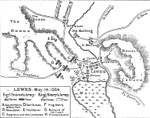Blackcap has been owned by the National Trust since 1993. It is on a peak of the South Downs, just south east of the village of Plumpton in East Sussex, England and west of Lewes. It is part of the Clayton to Offham Escarpment SSSI. The flatter landscape is made up of open ground with chalk paths, surrounded by thickets. The steeper ground leading up to the ridge is low-density woodland. The top is more open, with patches of pine woodland and gorse bushes, and there is a triangulation point.
Because of the height of the hill at 206 metres (676 ft), the top of Blackcap was largely spared the farmers' plough and the ground has not been "improved" for monoculture crop fields as much as the rest of Downs were after the second world war. Unimproved chalk downland is internationally rare and hosts archaic plants and rich biodiversity. As a result, this is an important area on the South Downs. The brow of Blackcap is still described by David Bangs as an area where, "Crows caw, Jackdaws squark, clouds pass, peace still reigns in this old-fashioned place". The hilltop offers some far reaching and impressive views, which encompasses Ashdown Forest northwards, Mount Caburn, Windover Hill (home of the Long Man), Firle Beacon, Seaford Head, Newhaven’s Rushy Hill, Kingston Hill, Hollingbury Hillfort, and Brighton’s high-rise towers.










